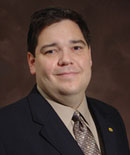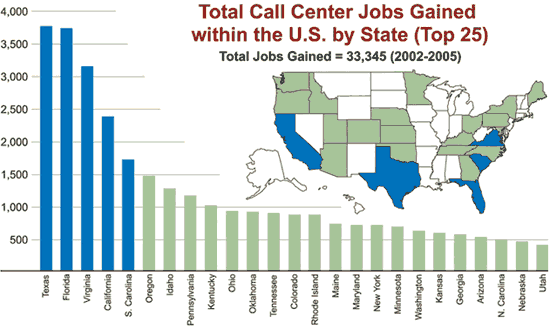MISSISSIPPI SPOTLIGHT
|
Call Center Central
Site Selection: How did the National Association of Call Centers come into being? David Butler: My doctorate from the University of Cincinnati is in economic geography, and my dissertation was on the U.S. airline industry's adoption of information technologies post-deregulation, in 1978. I found that when they were competing at that time, some interesting things happened. They leveraged IT pretty effectively in what was once concentrated in airline operations. At the same time, they dispersed some functions to reservation centers. At the time, literature on these centers and where they located did not exist. The more I looked at reservation centers, the more I realized there was a bigger industry in call centers. So what I thought was a niche market was in fact a huge cavern and an untouched cavern with respect to research. I've been researching call centers for about 10 years. Colleagues encouraged me to write something for the industry, so I published my book in 2004, in which I analyzed a lot of the primary data I had collected by surveying call center reps and managers to find out how they operate and how they can operate better. The book came out on the heels of the 2004 election and the debates over outsourcing and offshoring. The national business press picked up on that, and the university saw an opportunity to create a center of excellence. We created a call center research lab to work with the private sector, and the university bridged that gap. The center was founded in late 2004. SS: What is the association's mission? DB: NACC's goal is to professionalize and truly turn the call center industry into a traditional industry with all the professional trappings that come with it. Right now, the industry is less than 30 years old — I think of it as being in the teenager stage. We're trying to move it into adulthood. There are a lot of challenges that go along with that. But the starting point, stage one, is to get good data into everybody's hands and get everybody on the same page. Stage two, once we have the members, will be to plot a blueprint for where we want that industry to go. Stage three will be to sell that to the industry. And stage four is where the vendors in the industry build the capacity to get us there. At each stage, different types of people will be attracted to the industry and will jump on board. SS: Who are you targeting to be members of NACC? DB: Our market is the vice presidents of companies with call center operations, the people who make strategic decisions about one or more centers; directors with several call centers reporting to them; economic developers, both state level and local, who want insights into call center trends; and vendors offering equipment and services to the call centers. The latter are in the stickiest position because the industry is growing, and they're dumping a lot of capital into better services and equipment, but most of that doesn't stick. The industry hasn't fully formed — it hasn't gelled. It doesn't know what it wants yet or what it's becoming. The vendors are in a position to learn these trends and to know when to start growing and when it should start buying. SS: Describe some of the research NACC is working on at this time. DB: One graduate student is collecting public-source data on the call center industry, and another is collecting a list of Fortune 1000 company VPs who have customer service or call centers reporting to them, to name two ongoing efforts. Others will be doing interviews with call center directors in the financial services, transportation, tourism and government arenas to find out their experience pre-Katrina and post-Katrina and whether they have shifted operations and if they had disaster response plans. We will turn that research out through the research lab and through NACC. It will show which companies did well and which did poorly. In my view, financial service organizations were probably the fastest to respond. SS: What is your research telling you about which U.S. states are particularly active in call center activity in late 2005? DB: Oklahoma has been a great state in this area. Virginia and the Carolinas have done very well. Some states have done poorly, such as Massachusetts and Illinois. Florida and Texas are holding onto their marketshare, as is California. New York is losing some, and the Dakotas are not as popular as they used to be. The South is gaining. People are not staying away from New York and California, and sometimes management wants the call center nearby so they can control it. Call centers are the voice of the company. How far away from your headquarters do you want that to be? SS: Besides wages, what is behind the growth in non-U.S. call center markets, especially Canada? DB: The two largest call center markets in terms of total number of centers, employees and calls inbound or outbound are the U.S. and the U.K. All other markets — Canada, India, the Philippines and South Africa — are all serving one of those two markets. South Africa's call center industry is not growing to serve the continent of Africa. It's serving the U.K. The Philippines is serving the U.S. India is serving both as well as Australia. Right now, Canada is the compromise choice, and that's not bad. If you're a CFO or EVP and you're looking to cut costs and save money, your choices are to go to India where you're at a distance from your customers and management and where cultural and language issues are at play, or there's Canada. They speak English, the market is pretty transparent, there's a great exchange rate, sound IT infrastructure, good training programs and a well educated work force. So it's a great compromise. It's not India in terms of labor savings, but you also don't have the political instability. And you can get to a center in Canada within a day. Another reason is that labor markets in the U.S. can get overheated. I've studied Albuquerque, N.M., extensively — call centers were locating there right and left. The labor market got overheated in part because they didn't draw from the labor pool they could have, and before long, centers were cannibalizing each other, pushing wages up. No one wants to be in that situation, and Canada becomes a good option. It complements the U.S. very well.
|



